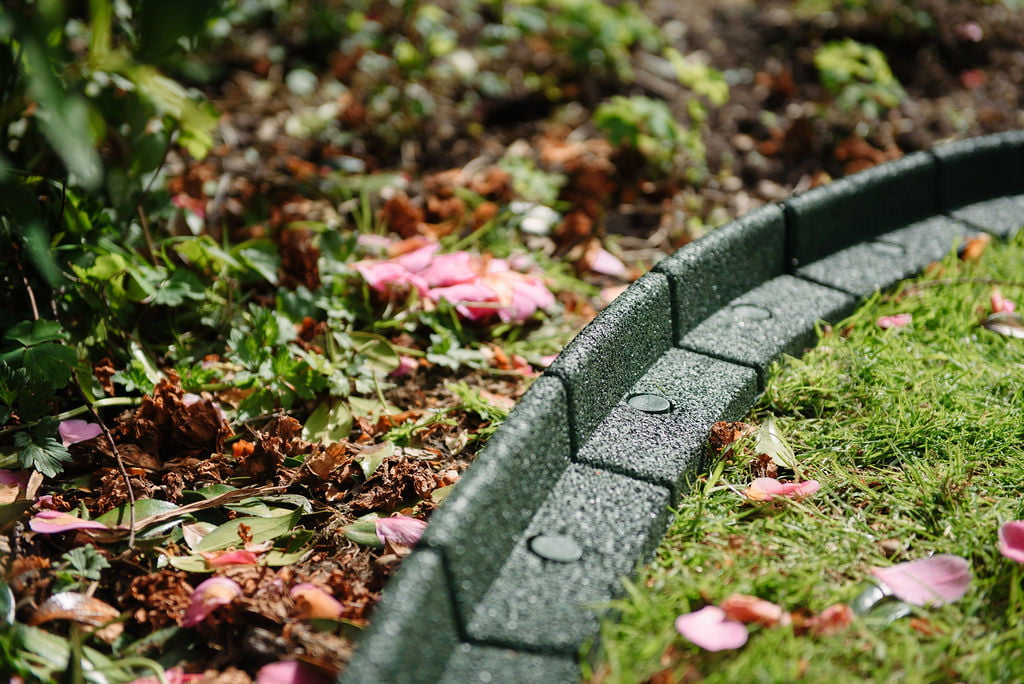Garden edging is used to define the edges of pathways, lawns or flowerbeds. There are a number of different options for this, from timber to metal or plastic, although our FlexiBorders are made from recycled tyres, which makes them more durable, hard wearing, and long lasting than other alternatives. But what are the general benefits of garden edging? And why should you consider this for your garden space?
What are the benefits of garden edging?
There are a number of benefits and advantages to installing effective garden edging. These can be split into three different categories:
- The visual benefits
- The practical benefits
- The environmental benefits
What are the visual benefits of garden edging?
There are several different visual benefits that effective garden edging can bring. These include:
- Adding a structured appearance to the garden – By installing garden edging you can create a clear distinction between different areas of the garden. This helps to create a structured and polished look to your garden space, defining the space between lawns, paths and flower beds. The clean and organised appearance that garden edging can create adds visual appeal to any garden space, improving the overall aesthetic.
- Highlighting the visual beauty of the plants – The distinction and separation that garden edging helps to create can be a great way to define and highlight the beauty of the flowers and plants in the flower bed, drawing the eye and allowing these to stand out.
- Creating shapes and patterns – Garden edging helps to create a defined shape in your garden space. This definition can complement your overall visual design aims, from a structured and formal space with straight lines and clear edges, to a more playful approach with curves bringing a sense of movement. So whether your borders or paths are straight or curved, garden edging can enhance these shapes and make sure that they stand out.
Practical benefits of garden edging
As well as the visual benefits of garden edging, there are also a number of practical benefits too. These include:
- Keeping grass and weeds from encroaching – The number one practical benefit to garden edging is its ability to keep grass and weeds from encroaching into flower beds and vegetable patches. This reduces the need for constant weeding and helps to maintain the distinct separation between different garden areas. It can also help your flowers grow without being impeded by weeds, which will outcompete them for nutrients.
- Saving maintenance time – Maintaining a garden with combined pathways, flower beds and lawns can be a challenge in all seasons, with soil or other materials seeping into different areas where they are not needed. By using garden edging, you can keep mulch, soil, and other materials in place, which can save time and effort in garden maintenance.
- Water management – Garden edging is also highly beneficial for water management, as the edges can prevent water run off, allowing your plants to receive the level of moisture they need, and preventing water wastage. This can also contribute to the even distribution of water, helping to keep your plants and flowers healthy and reducing problems with soil erosion.
- Creating zonal areas – In addition, edging also brings the benefit of creating zonal areas in the garden, which can help to organise your garden space and keep your flower beds protected from stamping feet or gardening equipment like lawn mowers or trimmers.
Environmental benefits
Finally, garden edging can also be beneficial from an environmental perspective, with several advantages including:
- Preventing the spread of invasive plants and weeds – The biggest environmental benefit of garden edging is that this helps to maintain the biodiversity of the garden, allowing native plants to thrive. The edges can prevent weeds from disrupting your flower beds, which is particularly important if you are growing native wildflowers.
- Ensuring an efficient use of resources – Using edging allows you to use the specific resources you need, in each specific area. This targeted approach can minimise waste and reduce the environmental impact of gardening activities. For example, by confining mulch and compost within specific beds, nutrients are kept where they are needed most, enhancing soil quality and promoting healthier plant growth, without needing as many top ups.
- Environmental benefits of edging materials – Finally, the right edging materials can also bring environmental advantages. Our FlexiBorder for example are made from old and destroyed tyres, a recycled material, that can also be recycled again after use. This is great for gardeners with an eco-friendly approach.
If you’re looking for an easy and environmentally friendly way to edge your lawns, pathways or flowerbeds, our FlexiBorder can be the perfect choice. Why not take a look at what we can offer today?




